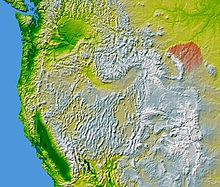Red cloud war
The Red Cloud's War (engl. Red Cloud's War ), also Bozeman Trail or Powder River War (1866-1868), according to the Oglala -Leader Red Cloud , was named an armed conflict between the United States and parts the Lakota , the northern Cheyenne and northern Arapaho . The war was fought for control of the Powder River area in north-central present-day Wyoming , which lay along the Bozeman Trail , a main access route to the gold fields of present-day Montana . The war ended with the Treaty of Fort Laramie in 1868 , which meant a complete victory for the Indians for the time being.
course
After gold was discovered in Idaho and Montana in 1862 and 1863, gold prospectors and settlers invaded the settlement areas of the Indians, who then increasingly fought back with raids from 1863 onwards. After the army failed in its attempt to reach a peace treaty with the Lakota that would allow settlers and prospectors to continue using the Bozeman Trail, it began military operations in 1866 under the command of Colonel Henry B. Carrington to secure the Bozeman Trail .
The US government believed the war was being organized on the part of the Indians by Red Cloud. The latter was a prominent war leader, but the Lakota, Cheyenne and Arapaho did not have a general commander in chief.
The Indians concentrated primarily on attacking the army's supply routes and besieging the forts built along the Bozeman Trail. However, they avoided a direct attack on fortified structures or larger army units. The biggest battles of the war were therefore called the Fetterman Massacre on December 21, 1866 the Hayfield Fight (dt. Hayfields command post ) on 1 August 1867 and the Wagon Box Fight (dt. Wagons command post) on August 2, 1867 During the Fetterman massacre, the Indians succeeded in ambushing an approximately 80-strong unit under the command of William Fetterman and rubbing it up completely. Apart from the Battle of Little Bighorn , this was the US Army's worst defeat in the Indian Wars.
In the two other skirmishes in the following year, however, a very small number of soldiers succeeded in repelling the attack by several hundred Indians with the help of modern firearms (the previously used muzzle-loaders had in the meantime been replaced by breech-loaders ) with only minor losses of their own . Despite these successes, the maintenance of the military operations along the Bozeman Trail became too costly for the US government, especially since it had to finance large troop units in the defeated southern states so shortly after the end of the Civil War . It was also foreseeable that the Bozeman Trail would soon become redundant, as the Union Pacific railroad would soon be completed. In the Fort Laramie Peace Treaty, which was finally signed on November 6, 1868 after lengthy negotiations, the government therefore fulfilled almost all of Red Cloud's demands, including the removal of all fortifications that the US Army had built along the Bozeman Trail.
Movie
Various events of the Red Cloud War, including the Fetterman massacre and the Wagon Box Fight , are taken up - with historical inaccuracies - in the US western Tomahawk - Sioux uprising from 1951.
See also
literature
- Drury, Bob / Clavin, Tom: The Heart of Everything That Is. The Untold Story of Red Cloud, An American Legend , New York 2013
- Robert W. Larson: Red Cloud: Warrior-Statesman of the Lakota Sioux . University of Oklahoma Press 1999, ISBN 0806131896 , pp. 74-104 ( excerpt from Google )
- George E. Hyde: Red Cloud's folk: a history of the Oglala Sioux Indians . University of Oklahoma Press 1937, ISBN 0806115203 , pp. 134-184 ( excerpt from Google )
- John H. Monnett: Where a Hundred Soldiers Were Killed. The Struggle for the Powder River Country and the Making of the Fetterman Myth . University of New Mexico Press, Albuquerque 2008 ( excerpt from Google ) <
- Spencer C. Tucker , James Arnold, Roberta Wiener: The Encyclopedia of North American Indian Wars, 1607-1890: A Political, Social, and Military History. ABC-CLIO 2011, ISBN 9781851096978 , p. 670 ( excerpt from Google ).
- Dee Brown : Buried my heart at the bend of the river , (Original title: Bury My Heart at Wounded Knee), translated by Helmut Degner, Knaur Taschenbuch 62804, Munich 2005, ISBN 978-3-426-62804-1 , Chapter 6
Web links
- So died a people's dream . DIE ZEIT, December 28, 1990 No. 01
Individual evidence
- ↑ Monnett, John H .: Where a Hundred Soldiers were killed. The Struggle for the Powder River Country and the Making of the Fetterman Myth . Albuquerque 2008, p. 4 . ( Excerpt from Google )
- ↑ Drury, Bob / Clavin, Tom: The Heart of Everything That Is. The Untold Story of Red Cloud, An American Legend . New York 2013, p. 308 .


